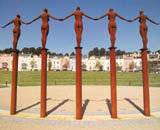Urban wasted space in need of designers’ input

An area the size of Greater London is lying derelict and vacant across England and Wales and poor urban design is largely to blame, according to the Commission for Architecture and the Built Environment’s Space arm.
Cabe Space, which launches its Wasted Space campaign this week, says that chronic under-investment has led to around 70 000ha of land being neglected at a time when urban regeneration is supposed to be a Government objective.
A Cabe Space spokeswoman says the initiative recognises ‘there has been a massive underinvestment in Britain’s public spaces’. Real investment in public space design has declined year on year since 1979, she says. The campaign is intended to identify nine of the ‘worst’ public spaces in Britain and raise awareness of the need for improved urban design.
Cabe Space will collaborate with communities and specialists – likely to include designers, architects and artists working in ‘creative teams’ – to help local areas realise improvements.
Cabe chairman Sir Stuart Lipton is calling for designers to rise to the challenge, bemoaning the failures of previous design for the public realm.
‘I find it hard to think of many examples of public spaces created during the past 50 years that have a feel-good factor. We have chosen for a long time to dress ourselves in rags,’ he says.
Cabe space deputy director Edward Hobson says British designers need to take a longer term view and focus on designing in maintenance requirements.
‘We have some good public spaces in the UK, but not to the level of quality as the Continent, particularly in designing for long- term management and maintenance,’ he claims.
The organisation cites Portishead Docks in Bristol, developed by Crest Nicholson, and Sheffield’s Winter Gardens, by architect Pringle Sheridan, as two successful regeneration schemes.
‘Portishead probably isn’t the most beautiful example of urban design, but it is a remarkable improvement and involves public art [the Angels of Portishead by Rick Kirby pictured].
A total of £201m has been earmarked by the Office of the Deputy Prime Minister for investment in urban regeneration. A spokeswoman for the ODPM insists that design ‘is fundamental’ to the success of the schemes’.
‘We’re hoping to create communities and neighbourhoods, not just bricks and mortar, and good design is central to that,’ she explains.
The Living Spaces campaign, launched in July, offers a fund of £30m set aside to help community groups improve local areas. Groups can apply for grants of between £1000 and £100 000 for regeneration projects.
To date 217 projects have been approved, encompassing work ranging from community gardens to play areas, local parks, village greens and seating areas.
A further £89m is to be distributed to 27 local authorities across nine English regions later this year. This is earmarked for the creation of urban space management strategies and capital projects.
-
Post a comment



